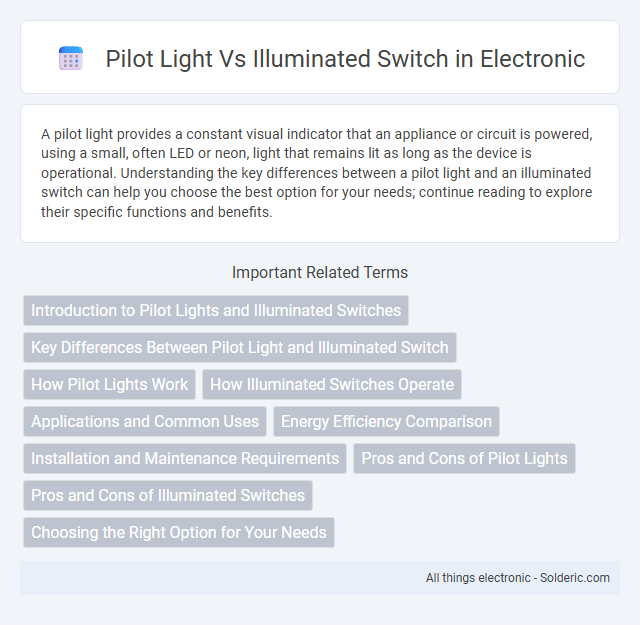A pilot light provides a constant visual indicator that an appliance or circuit is powered, using a small, often LED or neon, light that remains lit as long as the device is operational. Understanding the key differences between a pilot light and an illuminated switch can help you choose the best option for your needs; continue reading to explore their specific functions and benefits.
Comparison Table
| Feature | Pilot Light | Illuminated Switch |
|---|---|---|
| Definition | Small, continuously burning flame signaling appliance status | Switch with built-in light indicating power or operational status |
| Power Source | Gas flame (usually natural gas or propane) | Electrical current (AC or DC) |
| Function | Ignites main burner; signals appliance readiness | Shows switch activation or power flow visually |
| Energy Consumption | Constant gas usage, leading to small energy waste | Minimal electrical consumption, often LED-based |
| Safety | Potential fire hazard if not maintained properly | Safer; eliminates open flame risk |
| Maintenance | Requires regular inspection and cleaning | Low maintenance, mainly bulb or LED replacement |
| Applications | Gas appliances like furnaces, water heaters | Electrical appliances and devices |
Introduction to Pilot Lights and Illuminated Switches
Pilot lights and illuminated switches serve distinct functions in electrical systems, with pilot lights primarily indicating the status of machinery or circuits through a fixed light. Illuminated switches combine control and indication by integrating a light within the switch itself, providing visual feedback when the switch is engaged. Your choice between the two depends on whether you need a simple status indicator or a combined control and indication device for efficient operation monitoring.
Key Differences Between Pilot Light and Illuminated Switch
Pilot lights indicate the operational status of a device by showing a constant, low-intensity glow, often powered by a small dedicated bulb or LED. Illuminated switches combine the switching function with built-in lighting that activates when the switch is engaged or powered, offering both control and visual indication. Understanding these key differences helps you select the right component for clear status feedback and efficient device operation.
How Pilot Lights Work
Pilot lights operate by using a small, continuous flame or LED indicator that signals the operational status of a device or system, often found in gas appliances or industrial equipment. The pilot flame maintains a heat source that ignites the primary burner when needed, ensuring immediate ignition and safe operation. Illuminated switches, on the other hand, use built-in LEDs to visually indicate power status without relying on a physical flame, offering enhanced safety and modern aesthetics.
How Illuminated Switches Operate
Illuminated switches operate by incorporating a small, built-in light source, such as an LED or neon bulb, which activates when the switch is turned on, providing immediate visual indication of the circuit status. This lighting mechanism is powered by the same electrical current that controls the device, ensuring synchronized illumination and functionality. Unlike pilot lights, which are separate indicator units, illuminated switches combine the switch and indicator in one compact component, enhancing user convenience and energy efficiency.
Applications and Common Uses
Pilot lights are commonly used in industrial equipment and control panels to indicate the operational status of machinery, making them essential for safety monitoring and troubleshooting. Illuminated switches are prevalent in household appliances and consumer electronics, providing users with immediate visual feedback on power or function activation. Both devices enhance user interface efficiency but differ in application scope, with pilot lights favored for industrial environments and illuminated switches for everyday consumer products.
Energy Efficiency Comparison
Pilot lights consume a continuous small amount of gas or electricity, leading to constant energy use even when the main appliance is off, which reduces overall energy efficiency. Illuminated switches only draw power when the switch is activated, significantly lowering standby energy consumption and enhancing energy efficiency. Choosing illuminated switches over pilot lights can result in notable energy savings and reduced utility costs over time.
Installation and Maintenance Requirements
Pilot lights require wiring directly into the control circuit and periodic bulb replacement, making installation moderately complex and maintenance essential to ensure visibility. Illuminated switches integrate the light source within the switch assembly, simplifying installation with fewer components and reducing ongoing maintenance demands. Choosing between the two can affect your system's reliability and upkeep efficiency based on ease of access and component lifespan.
Pros and Cons of Pilot Lights
Pilot lights offer clear visual indication of device status and consume minimal energy, making them ideal for continuous operation in control panels. Their simple design ensures reliability and low maintenance, though they can be less versatile compared to illuminated switches that often provide customizable colors and integrated functions. Your choice depends on whether you prioritize durability and straightforward signaling or flexibility and aesthetic options in your control system.
Pros and Cons of Illuminated Switches
Illuminated switches offer clear visibility in low-light conditions, enhancing user convenience and safety. They can indicate the operational status of connected devices, reducing the likelihood of accidental activation or leaving equipment on. However, illuminated switches may consume more energy than non-illuminated options and could present maintenance challenges if the light source fails.
Choosing the Right Option for Your Needs
Selecting between a pilot light and an illuminated switch depends on visibility and function requirements. Pilot lights provide a continuous visual indicator, ideal for monitoring equipment status in industrial settings. Illuminated switches combine control and indication in one unit, suitable for user interfaces needing both tactile feedback and immediate status confirmation.
pilot light vs illuminated switch Infographic

 solderic.com
solderic.com